AMD vs. Intel: Battery Life Investigated
by Jarred Walton on August 5, 2009 5:00 PM EST- Posted in
- Laptops
Laptops: Comparing Apples to Apples
Anyone looking to go out and purchase a new laptop is almost certainly interested in a couple things: how much does it cost, and what sort of battery life can you expect? Answering those questions for any specific laptop is simple enough, provided we can get a sample unit for testing. However, it becomes more difficult to answer these questions when you're looking at the big picture -- i.e. AMD vs. Intel laptops. The pricing question is easier: laptops using AMD platforms are (usually) cheaper than equivalent Intel platform laptops. That's simple enough: you're paying more for the Intel brand. But what about battery life?
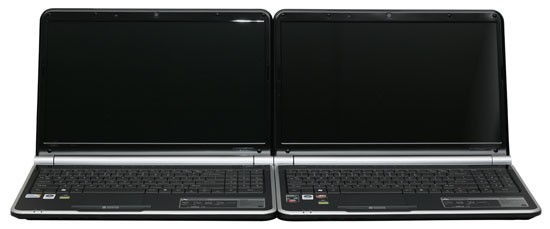 |
We have long tried to answer that question, but the best we could do up until this point was to compare "similar" laptops. Getting the same LCD, hard drive, optical drive, and most importantly battery has been very difficult -- so difficult that we have not been able to do it. A few manufacturers offer competing AMD and Intel laptops with very similar specifications, but no one seemed willing to send their AMD-based system. Were they afraid of cannibalizing sales of their more expensive laptops? Did they just think that an AMD-based laptop wouldn't stand up well in our testing? We don't know for sure, but what we do know is that Gateway has stepped up to the plate and sent us two all but identical laptops. We've been busy the past week or two putting the laptops through our test regimen, and we will have the full review shortly. In the meantime, we thought you might be particularly interested in the battery life you can expect.
Here's a quick look at the two laptops. On top is the AMD-based Gateway NV52, and below it is the Intel-based Gateway NV58.
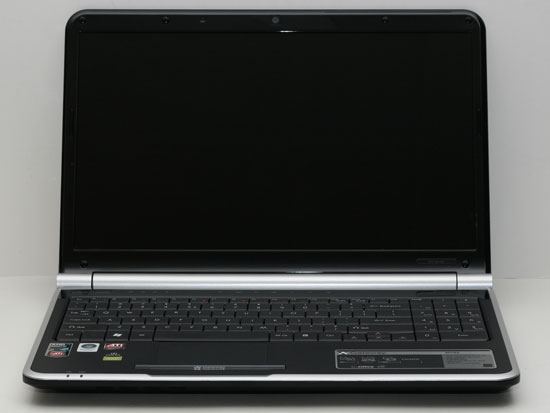 |
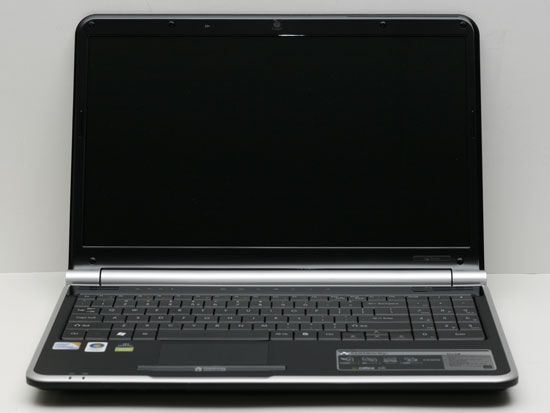 |
Here's a second look, focusing on the keyboards. Once again, AMD is above and Intel is below.
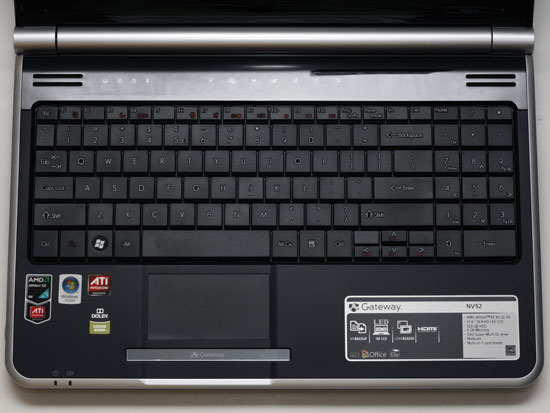 |
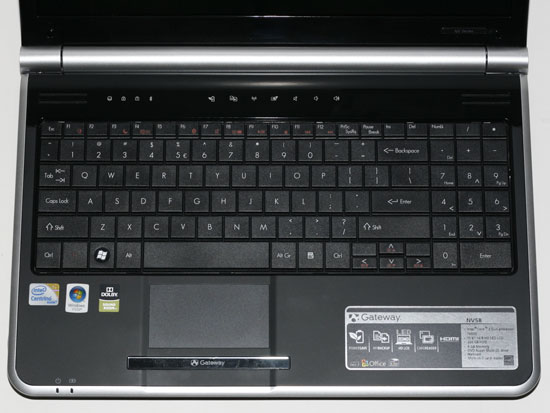 |
The chassis are identical from the outside, and everything else is the same as well other than the motherboard, chipset, and processor. Both come with 4GB DDR2 memory, a 15.6" 1366x768 LED backlit LCD, 320GB 5400 RPM hard drive, and a DVDRW. Both also include Gigabit Ethernet and 802.11n WiFi (Intel WiFi Link 5100 for the NV58 and Atheros AR928X for the NV52). In fact, even the CPUs have the same 2.1 GHz clock speed -- not that CPU clock speed matters -- as well as 35W TDP ratings -- not that that matters either, as we'll soon see. On the AMD side, we have the QL-64 (65nm, 2.1GHz, 2x512K L2, 3600MHz HyperTransport bus), and on the Intel laptop we have the T6500 (45nm, 2.1GHz, 2MB shared L2, 800MHz FSB). We should also mention that the NV58 costs more than the NV52, $500 for the NV52 and $580 for the NV58. What does the extra $80 buy you?
We will have performance numbers in our upcoming full review, but considering this is a match between AMD's old dual-core Athlon 64 X2 (K8 architecture) and Intel's Core 2 Duo, you can probably already guess the results. Intel is quite a bit faster in all of the CPU benchmarks. On the other hand, the AMD platform comes with much better integrated graphics, so if you would like to do a bit of 3D gaming on occasion (at low to medium detail levels) AMD easily wins the graphics benchmarks. Now let's look at battery life.










80 Comments
View All Comments
wiak - Friday, August 7, 2009 - link
like the subject says, ati or nvidia graphics are superior to anything intel has, its a fact, just see any benchmark ;)tygrus - Monday, August 10, 2009 - link
Add in a low end nvidia GPU and the price goes up another $150+ and maybe 20% less battery life ?In future articles: consider performance per watt (you said performance will be in the final review); measure power load on battery/mains(minus battery) over time for different tasks/conditions; multiple configs to indicate scailing and normal trends.
Isolate system components: use external LCD to switch off local screen (acroos varying laptops); swap HD; USB DVD drive compared to internal; swap RAM and change speed (very minor); swap mini-card wireless if possible... Hours of fun for the whole familly ... Who's paying you ask ? .. Don't look at me :)
alexruiz - Tuesday, August 11, 2009 - link
Interesting article. I personally am at a loss regarding battery life in laptops. Let me tell you my experience:I bought an emachines M6805 in Jan 2004. As you remember, this machine was the darling of power laptop users in a budget (~$1600) The machine had a mobile Athlon 64 3000+ clawhammer (130 nm) rated at 65 W and 11W in idle. It had a discrete mobility radeon 9600 and a desktop chipset VIA K8T800. Intel had not a CPU that could compete in raw performance with the mobile clawhammer as it only had the mobile P4 or the P-M banias at the time of the mobile Athlon 64 launch, both of which the clawhammer handled easy. It wasn't until the P-M Dothan than Intel matched the mobile clawhammer in performance while achieving lower power consumption.
Back into power consumption, the M6805 could go 2:30 - 2:45 hrs running under battery. Some guys even managed to reach 3:10 hr. You would think to achieve that battery life with that kind of horsepower and hungry parts would reuire an immense battery, remember, the K8T800 was a desktop chipset and the mobility radeon 9600 was a discrete powerful videocard, plus the mobile Athlon wa srated at 65W!
Well, the battery was only 6 cells rated at 4400mAH.... not big at all. I managed 3:05 hrs after switching form xP to win2K as the powernow worked more efficiently. When I replaced the hard drive for a travelstar 7K60 I only lost 12-15 mins of battery life.
Fast forward 5 and a half years. I finally sold my trusty M6805, mainly because at its size flying couch class isn't too practical. After a ot of time spent in shopping comparison, its replacement was a Toshiba U405D-S2910. The Toshiba sounds years ahead in paper (and it really is years newer) Turionn X2 RM-74 65nm "Griffin" rated at 31 W, 780v chipsetd with integrated graphics, 13.3" screen... one of the very first thing I did when I got it was to check the battery capacity.. the same 4400 mAH.
If the M6805 with hungry components and a bulky frame managed 2:40- 3 hrs on the same batteyr battery, the U405D shousd easily manage over 4 hrs I thought.... big dissapointment. It never went beyond 2:40 hrs, in fact, 2:30 seems to be the average. Why much more efficient components in a very smaller chasis manage the same battery life is beyond me. :(
However, for the $649 I spent I would not have gotten such a well rounded machine with an intel CPU at that size. I do game on the laptop while on the road, and the game is not easy on the graphics.. it still runs decently. The machine feels faster than many other machines costing twice... clean install of vista ultimate AMD64 in a WD scorpio black works wonders.... It is very slim, looks very elegant and is very quiet. For the $80 premium of the intel CPU I can buy another battery and double my time away from an outlet... oh, and I have the better graphics. But still, why is not beating the M6805?
JarredWalton - Wednesday, August 12, 2009 - link
mAhr is only part of the battery capacity equation; you also have to look at voltage. Multiply mAhr by voltage to get mWhr, which is the true measure of capacity. (Divide by 1000 for Whr.)As for performance, there are plenty of options out there. See the follow-up article posting shortly....
strikeback03 - Friday, August 7, 2009 - link
And to many of us that really doesn't matter. What's your point?medi01 - Monday, August 10, 2009 - link
And for many of us it still does matter, so what's your point?When someone compares AMD laptop to Intel laptop, people think about CPUs. But it is actually CPU + Graphic card and the performance gap between graphic cards is much wider in AMD's favor than performance gap between CPUs is in Intel's.
JACKDRUID - Thursday, August 6, 2009 - link
Intel offers much better battery life... However, i would NEVER ever buy a Intel laptop. Why? because its IGP sucks! its at least 2 to 3 times slower than AMD counter part. you are very likely be running any game at 10 fps with Intel IGP, while with AMD you might get 20-30fps. thats a differece between playable vs non-playable...if you insist on getting an Intel part, make sure you get one with dedicated graphics.
fumigator - Friday, August 7, 2009 - link
I agree.I serviced a Pentium DualC. T4000 series laptop recently, it came with IGP GMA4500, and it could hardly handle winamp visualisations! in some segments I got less than 10 to 15 frames per second! Come on people,
I understand the intel laptop is perfect for browsing the web and email, but... are we a Grandma or what? Are we going to sacrifice 80 bucks just to get 30 minutes more of battery life? maybe I could buy a whole new battery with that amount. And even windows installation was slow on that thing, but I don't care too much as its a one time procedure, but... a minimal overpower for multimedia should always be welcome... Cheap Intel laptops are a no go for me...
On the other side, if the laptop is AMD based, I would go ATI 3200 or up (780G). I dislike those X1000 series of ATI videos, which also means they sport the old SB600 southbridge. I would avoid it.
garydale - Thursday, August 6, 2009 - link
One point that I think needs to made is that the Intel notebook costs $80 more than the AMD. Given the fact that we're talking a $500 AMD unit, that's a pretty hefty price differential.On the performance side, the article mentions that the Intel notebook has the faster CPU but the AMD has the faster graphics. This makes it a toss-up in terms of power so for your extra money.
IMHO a better comparison would be two similar notebooks at the same price point. This would allow us to see the power versus battery life trade-off which I think is more relevant to most people.
blackshard - Thursday, August 6, 2009 - link
Watching to the keyboards, the AMD notebook lacks the "Power Saver" logo. I wonder it means somethings. BTW QL parts are really the entry level and lacks some power management features that RM and ZM series have. A comparison between QL, RM and ZM would be really nice, at least to see if the claims about advanced power management on RM/ZM are true.